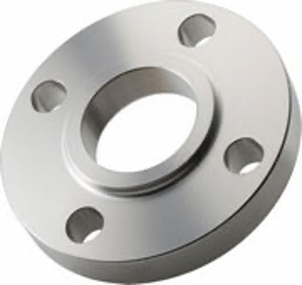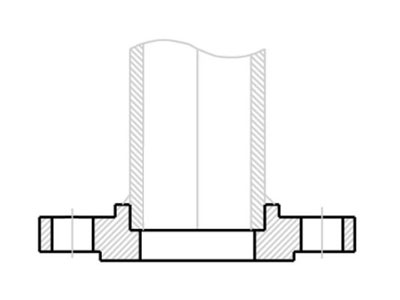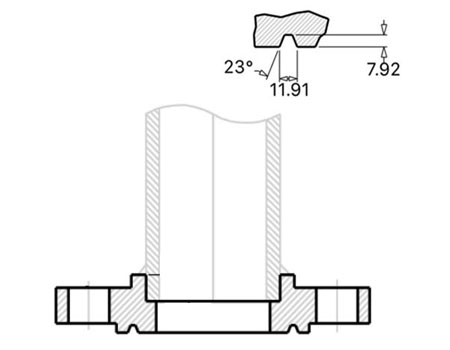Flanges
Manufacturer, Exporters & Supplier of
Slip On Flange
Slip On Flange
Slip on flange, also called SO flange. It's a kind of flange slides over the pipe with internal design is slightly larger than the pipe. Since the inner diameter of the flange is slightly larger than the outer diameter of the pipe, the SO flange can be directly connected to equipment or pipe by fillet weld at the top and bottom of the flange. It is used to insert the pipe into the inner hole of the flange.

Our Supply Range
Standard: ASTM A105, ASTM A182
Material: Carbon Steel, Alloy Steel, Stainless Steel
Size: 1/2'' to 24'', customized up to 60''
Pressure Ratings: Class 150 to Class 2500
Face Type: RF, RTJ
Types of Slip On Flange Welding
The SO flange can be divided into SO welding plate flange and SO welding hubbed steel pipe flange. Its mechanical characteristics are between the integral flange and the looping flange. The structure is simple, and the processing is convenient. So slip on flange welding is widely used in various fluid pipelines.
Depends on different face, there are also ranges raised face type and ring type joint face type.
Raised Face Slip On Flange
There is a small portion extruded from the bottom face of the slip on flange, this type is raised face slip on flange. The function of this area is to place a gasket seat during installation to get a better sealing performance.
As the pressure ratings bigger, the height of this raised face will be bigger.

RTJ Slip on Flange
A small grooved is machined on the raised face part, this form is called RTJ type, the function of this groove is to place the gasket ring, also applied for sealing, compared to RF type, RTJ is designed for high pressure use.

Slip on flange use slip welding to connect equipment, so either below of name is describing the same flange:
- Slip on weld flange
- Slip on flange weld
- Weld slip on flange
- Slip on flange welding
- SO flange
Referred Standard and Grades
ASTM A105 for carbon steel slip on pipe flanges.
ASTM A182 for alloy and stainless slip on flanges. (Alloy for F11, F22, stainless for F304/F304L, F316/F316L)
ASME B16.5 for pipe flanges and flanged fittings.
BS 3293
DIN 86029
Dimensions and Pressure Ratings
Common outer diameters: 1/2'', 2'', 3'', 4'', 6'', 8'', 10'', 12'', to 24”.
Special made outer diameters: Up to 60”.
Class range: Class 150, Class 300, 400, 600, 900, 1500, 2500(# or LB). PN 2.5 to PN 250.
Flange face type: RF (Raised Face), RTJ (Ring Type Joint)
Manufacturing Types
Slip on flange can be made by forging, steel cutting, casting and etc. Among these manufacturing types, the forging type gains the best quality and also the most common use, price is higher than other types. So before purchase the slip on flange, you have to know what is the specific working environment.
Advantages of Slip On Flange
- Lower installation costs
- More easy to align with other parts during installation
- Better leaking proof
- Inner and outer welding on flange
- Takes less time to cut accurately for the pipelines
- As pipe slides on the flange, it compatible with lower hub on slip on flange
Slip On Flange vs Weld Neck Flange
- The strength for internal pressure of Slip On Flange is two-thirds of Weld Neck Flange.
- Durability life is 1/3 of WN flange.
- 2 fillet welding required for SO flange, one inside and one outside of flange.
- A space shall be reserved between the end of the pipe and the end of the flange during welding work, to avoid damage the flange face.
- Slip on flange has to connect with a pipe firstly, then connect a fitting. (Combination of flange+elbow, or flange+tee not available, since the fittings not in a straight end, it can not slide completely into the flange bore. )
Slip on flange are usually cheaper than Weld-Neck flange (welding neck flange), which is why many customers prefer to choose them. It is one of the commonly used flanges for low pressure, medium temperature piping system.
On the other hand, since the flange bore is larger than the pipe diameter, it usually requires more welding work than the other flanges. So the durability is not as long as the welding neck flange, all of these factors should be considered before choose a right flange.